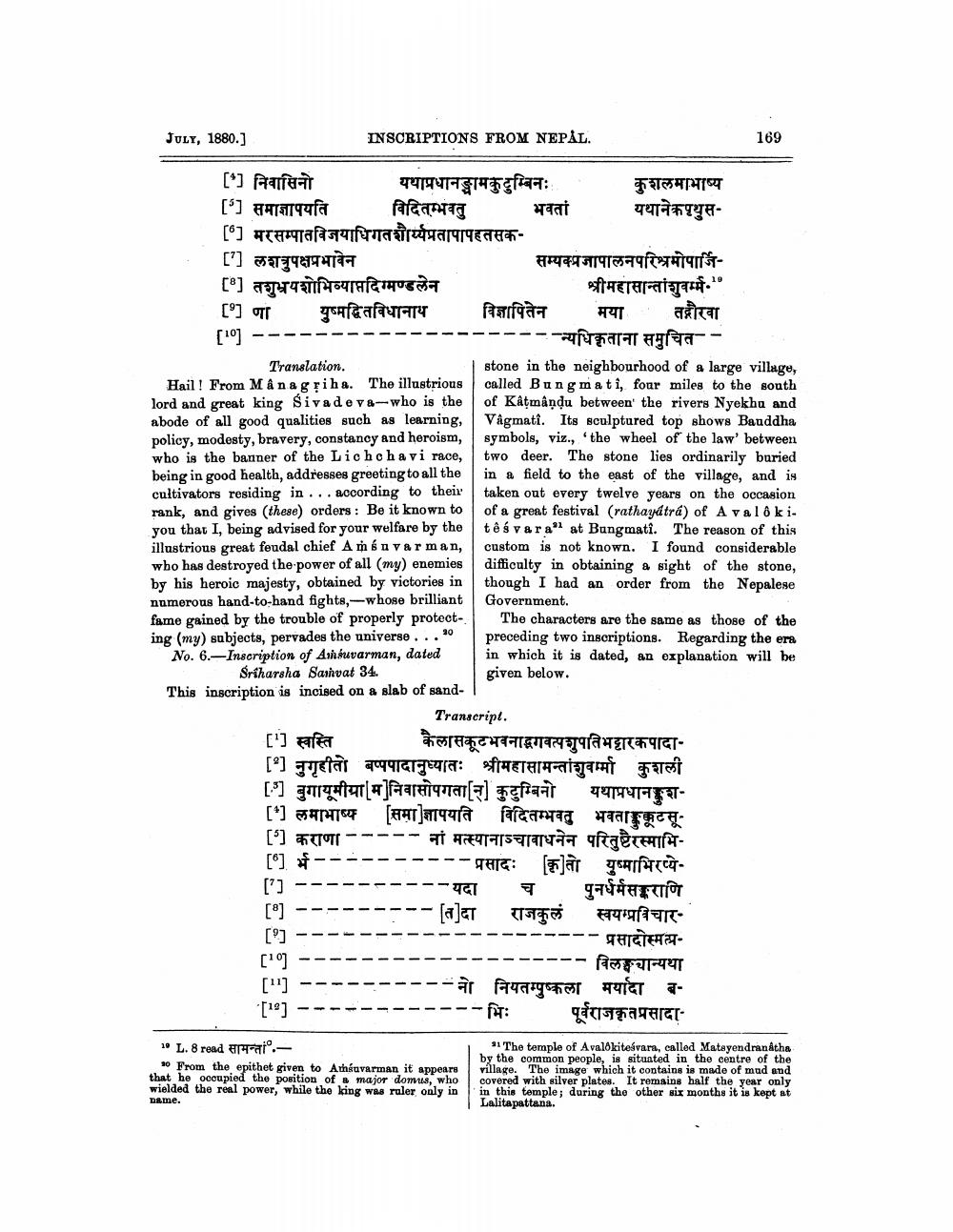________________
JULY, 1880.]
[2] निवासिनो
यथाप्रधानङ्ग्रामकुटुम्बिनः विदितम्भवतु
[5] समाज्ञापयति
[] मरसम्पातविजयाधिगतशैय्र्यप्रतापापहलसक
INSCRIPTIONS FROM NEPAL.
[] लशत्रुपक्षप्रभावेन
[] तशुभ्रपशोभिव्याप्तदिग्मण्डलेन [9] णा युष्मद्धितविधानाय
[10]
Translation.
Hail! From Mânagriha. The illustrious lord and great king Sivadeva-who is the abode of all good qualities such as learning, policy, modesty, bravery, constancy and heroism, who is the banner of the Lichchavi race, being in good health, addresses greeting to all the cultivators residing in... according to their rank, and gives (these) orders: Be it known to you that I, being advised for your welfare by the illustrious great feudal chief A mén varman, who has destroyed the power of all (my) enemies by his heroic majesty, obtained by victories in numerous hand-to-hand fights,-whose brilliant fame gained by the trouble of properly protecting (my) subjects, pervades the universe... 0 No. 6. - Inscription of Anśuvarman, dated Sriharsha Samvat 34.
This inscription is incised on a slab of sand
[7]
[#]
[2]
[10]
["]
[["]
भवतां
कुशलमाभाष्य यथानेकप्रस
सम्पदप्रजापालन परिश्रमोपार्जि श्रीमहासान्तांशुर"
10 L. 8 read सामन्तां .
10 From the epithet given to Amhsuvarman it appears that he occupied the position of a major domus, who wielded the real power, while the king was ruler, only in
name.
Transcript.
[1] स्वस्ति
कैलाशकूट भवनाद्भगवत्पशुपति भट्टारकपादा
[4] नुगृहीतो बप्पपादानुध्यातः श्रीमहासामन्तांशुवर्मा कुशली [5] नुगामीया [म] निवासोपगता [न्] कुटुम्बिनो यथाप्रधान कुश[4] लमाभाष्य [ समा] ज्ञापयति विदितम्भवतु भवताङ्कुक्कूटसूनां मत्स्यानाञ्चावाधनेन परितुष्टैरस्माभिप्रसादः [कृ] तो युष्माभिरप्येच पुनर्धर्मसङ्कराणि
[5] कराणा
[5] र्भ
विज्ञापितेन मया तगौरवा न्यधिताना समुचित
'यदा [[]] दा राजकुलं
stone in the neighbourhood of a large village, called Bung mati, four miles to the south of Katmandu between the rivers Nyekhu and Vâgmati. Its sculptured top shows Bauddha symbols, viz., ' the wheel of the law' between two deer. The stone lies ordinarily buried in a field to the east of the village, and is taken out every twelve years on the occasion of a great festival (rathayátrá) of A valô kitêsvara" at Bangmati. The reason of this custom is not known. I found considerable difficulty in obtaining a sight of the stone, though I had an order from the Nepalese Government.
19
The characters are the same as those of the preceding two inscriptions. Regarding the era in which it is dated, an explanation will be given below.
स्वयम्प्रविचारप्रसादस्म
लिचान्यथा
नो नियतम्पुष्कला मर्यादा ब*भिः पूर्वराजकृतप्रसादा
169
31 The temple of Avalokitesvara, called Matayendranatha by the common people, is situated in the centre of the village. The image which it contains is made of mud and covered with silver plates. It remains half the year only in this temple; during the other six months it is kept at Lalitapattana.




